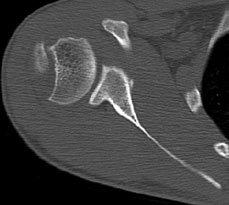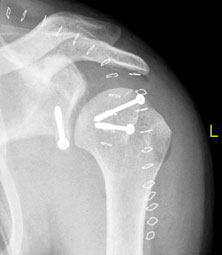Combined shoulder techniques effective for glenoid bone loss, complex instability
The treatment of glenoid bone loss and also hypoplasia requires understanding the bony anatomy, using an array of surgical techniques.
GENEVA — To treat complex shoulder bone loss and instability, surgeons should rely on their knowledge base for successful outcomes rather than on evidence-based medicine alone, according to a shoulder surgeon from Oslo.
“In really complex cases like this, you cannot rely on performed studies alone. You need to combine techniques and always try to find the best solution,” Tom Clement Ludvigsen, MD, said in a keynote lecture at the European Society of Sports Traumatology, Knee Surgery and Arthroscopy Congress 2012, here. “You need really a large toolbox to take care of these patients and must combine the tools that you have.”
“In this situation, extensive knowledge of anatomy and function is critical,” he said.

Shown is an extensive Hill-Sachs fracture and anterior glenoid bone loss in a patient with seizures.
Images: Ludvigsen TC
Differing amounts of bone loss in shoulder instability cases require variations in the procedures typically used, Ludvigsen said. He uses an open Latarjet procedure or arthroscopic Bankart repairs in the absence of bone loss.
“We have to calculate if there is bone loss or not. If there is no bone loss, we do a normal arthroscopic Bankart [procedure], or an open Latarjet if the soft tissue is not good. The decision is made at arthroscopy,” Ludvigsen said.
For moderate bone loss, he uses a Bankart or combined Bankart and Remplissage procedure with bone grafting. However, extensive bone loss in the presence of Bankart and/or Hill-Sachs lesions requires an open Latarjet technique and placing iliac crest bone graft to fill the defect.
“In cases like this, it is useful to do a combined procedure where we take bone graft from the iliac crest that we shape to fit … Usually we shave … well into the Hill-Sachs defect and [perform] a modified Latarjet procedure at the glenoid defect,” he said.
Latarjet surgery for the shoulder has a low 3% recurrence rate and is supported in the literature by studies with long-term results, according to Ludvigsen. However, despite his success with this surgery, he said Latarjet procedures have a slightly increased rate of osteoarthritis in long-term follow-up studies and some loss of external rotation postoperatively.

The patient with seizures was treated with a combined Latarjet procedure and transfer of iliac crest bone to the Hill-Sachs defect.

An open Scott osteotomy of the neck of the scapula and a modified Eden-Hubinette was used to treat instability due to glenoid hypoplasia.
A combined arthroscopic procedure has been useful in Ludvigsen’s hands and has not led to osteoarthritis, he said. “It is tolerated well and has excellent stability.”
For rarer conditions and increased instability and pain, such as glenoid hypoplasia, Ludvigsen recommends a posterior Bankart procedure, using a subanterior arthroscopic approach in mild cases. More severe or recurrent instability combined with glenoid hypoplasia may be resolved with an open osteotomy of the neck of the scapula. Glenoid fracture and dislocation were reported with arthroscopic osteotomies for hypoplasia, he said.
Regardless of treatment preference, following evidence-based medicine only is not enough in these rare cases, Ludvigsen said. Furthermore, more level 4 studies and related expert opinions are needed in the absence of studies with large patient cohorts, he said.
“We talk about evidence-based medicine. That is very good, but it is not everything, especially not in rare cases like this,” Ludvigsen said.
He told Orthopaedics Today Europe, “When treating complex shoulder instability, it is essential to have the ability to combine open and arthroscopic techniques. We therefore have to educate our young fellows also in open shoulder surgery to become true experts in the field.” – by Jeff Craven
Reference:
- Ludvigsen TC. Complex instability problems related to bony deformities. Paper #KN25-5055. Presented at the European Society of Sports Traumatology, Knee Surgery and Arthroscopy Congress 2012. May 2-5. Geneva.
For more information:
- Tom Clement Ludvigsen, MD, can be reached at the Department of Orthopaedic Surgery, Ulleval Hospital and Oslo University, Kirkeveien 166, 0407, Oslo, Norway; email: t.c.ludvigsen@ioks.uio.no.
- Disclosure: Ludvigsen has no relevant financial disclosures.
